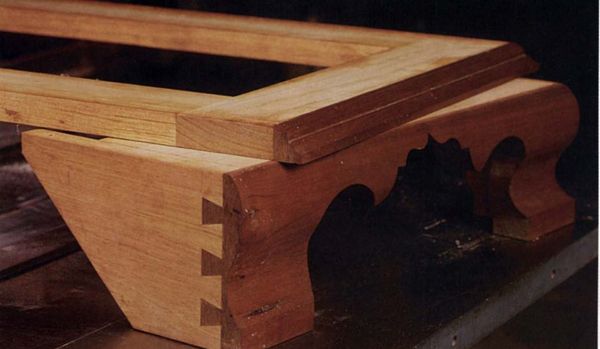Bracket Feet for Case Pieces
Separate base avoids cross-grain destruction
Synopsis: As a cabinetmaker specializing in furniture reproductions, Norm Vandal has experimented with several techniques for making and attaching traditional bracket feet. In order to avoid the joint failures and cracked carcase sides found on so many period pieces, he devised a separate-base system that avoids the problem of crossgrain construction. You can apply the same principles to other styles of carcases where you must balance the need for strength with a way to accommodate seasonal wood movement
As a cabinetmaker specializing in furniture reproductions, I’ve experimented with several techniques for making and attaching traditional bracket feet. I’ve always admired the stylistic effect of these feet, but I want to avoid the joint failures and cracked carcase sides found on so many period pieces. I’ve devised a separate-base system that avoids the problem of crossgrain construction.
Cabinetmakers have been wrestling with these structural problems since the advent of central heating. The 18th-century workers got away with attaching moldings cross-grain to sides and with other cross-grain constructions because their homes didn’t experience such drastic humidity changes. I don’t want to sacrifice the historical integrity of my reproductions, but I don’t want the pieces to self destruct either.
My separate-base system provides adequate support and maximum allowance for wood movement. I joined the case with half-blind dovetails, rather than the easier-to-cut through dovetails, so that I wouldn’t have to hide the visible tails behind a molding as the early makers did. This meant I could locate the base molding lower on the case side as part of a separate base upon which the chest can sit.
I also began attaching bases, moldings and drawer runners by 72 Fine Woodworking using a specialized, but common, router bit called a picture-hanging bit. This bit, available from most woodworking supply houses, cuts a T-shaped slot, as shown in the top photo on the facing page, which forms a perfect mate to a #10 Phillips pan-head sheet-metal screw. After slotting the back sides of moldings or drawer runners, I could screw these pieces snugly to a case side and still allow critical wood movement. Also, the frames of bracket bases can be similarly slotted to fit screws fastened in the case bottom – again a good, strong connection that allows wood movement.
Although the separate bases I’ll discuss in the article were developed for traditional bracket feet designs, like the one in the photo above, you can apply the same principles to other styles of carcases where you must balance the need for strength with a way to accommodate seasonal wood movement.
For the full article, download the PDF below:
From Fine Woodworking #97
Fine Woodworking Recommended Products

Festool DF 500 Q-Set Domino Joiner

Starrett 12-in. combination square






















Log in or create an account to post a comment.
Sign up Log in